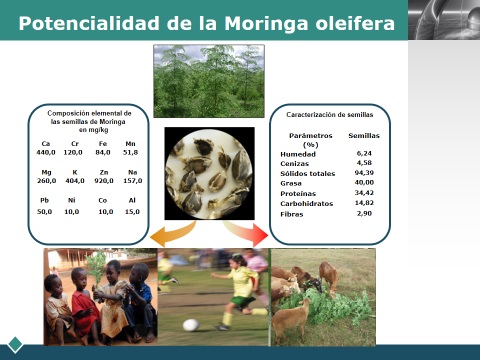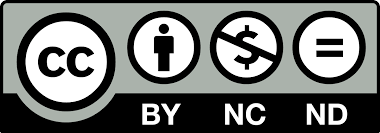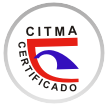Potencialidad de la semilla de Moringa como ingrediente alimenticio beneficioso para la salud
Palabras clave:
Moringa oleifera Lam; semillas; nutrientes; salud humanaResumen
La cantidad de nutrientes en un alimento determina su calidad. El objetivo del trabajo fue cuantificar la
composición química (macronutrientes, micronutrientes, ácidos grasos, análisis próximo y propiedades
físico-química) del polvo y aceite de semillas de Moringa oleifera Lam. ecotipo Plain, aclimatada en Cuba,
y se resaltan los beneficios que aporta su consumo a la salud humana. Se prepara la muestra y se caracteriza
el polvo y el aceite de la semilla, utilizando procedimientos normados o establecidos previamente. Los
resultados demuestran, que estas semillas tienen altos niveles de grasa y proteínas. Además de los minerales
presentes como calcio, cinc, potasio, hierro, magnesio, corroborando la potencialidad de este cultivo como
aditivo en diferentes matrices alimentarias, beneficioso para la salud.
Citas
BENÍTEZ B, col. “Formulación y evaluación fisicoquímica, microbiológica y sensorial de galletas enriquecidas con linaza como alimento funcional”. Archivos Venezolanos de Farmacología y Terapéutica. 2017; 36, (4): pp. 4106- 4113, ISSN: 0798-0264.
MAHMOOD, T.; MUGAL, T.; & Ul, I. (2010). Moringa oleifera: a natural gift-A review. Journal of Pharmaceutical Sciences and Research, 2(11): pp 775-781, ISSN: 0975-8232.
GULSHAN KUMAR et al. “Multifaceted applications of different parts of Moringa species: Review of present status and future potentials”. International Journal of Chemical Studies 2019; 7(2): pp 835-842, ISSN: 2321-4902.
LIÑÁN, T. F. “Moringa oleifera el árbol de la nutrición”. Ciencia y salud virtual, 2010, 2 (1): pp 130-138. https://doi.org/10.22519/21455333.70, ISSN: 2114-5333.
HODAS, F.; ZORZENON, M. R. T.; MILANI, P. G. 2021. Moringa oleifera potential as a functional food and a natural food, additive: a biochemical approach. An Acad Bras Cienc 93: e20210571. https://doi.org/10.1590/0001-3765202120210571. ISSN 0001- 3765.
PEDRO DÁVILA, F.; RAMIRO GALLEGOS, G. “Determination of sodium, potassium, iron, zinc and, calcium in three legumes: chickpeas, soybeans and peanut by flame atomic absorption spectrophotometry”, info ANALÍTIC, 2016, 4, (2): pp. 9-19, ISSN: 2477-8788.
GARCÍA, O I. R.; RIVERA, C. “Las leguminosas, una fuente importante de fibra alimentaria: Una visión en Venezuela”. Revista del Instituto Nacional de Higiene “Rafael Rangel, 2009, 40 (1): pp. 57-63, ISSN: 0798-0477.
FERRER, S. C.; LLERENA, F. P.; MAZORRA, M. M. Moringa: Árbol de múltiples usos. Editorial Bolívar y Martí, Caracas, Venezuela, ISBN:00000000000 978-980-7694-00-1, 2014.
RAMACHANDRAN.C PKV, GOPALAKRISHNAN.P:K. DRUMSTICK. Moringa oleifera: A Multipurpose Indian Vegetable. Economic Botany. 1980, 34: pp 276-283, ISSN:1874-9364.
ANWAR, F. Moringa Oleifera: A Food Plant with Multiple Medicinal Uses. Phytotherapy Research. 2007, 21 (1): pp. 17-25, ISSN: 0951-418X.
DIXIT, S.; TRIPATHI, A.; KUMAR, P. “Medicinal properties of Moringa oleifera: A review”. International Journal of education and Science research review, 2016, 3(2): pp. 173-184, ISSN: 2348-6457.
KAWO, A. H. et al. “Preliminare Phytochemical Screening, Proximate and elemental composition of Moringaoleifera Lam Seed Powder Bayero”. Journal of Pure and Applied Sciences, 2009, 2 (1): pp 96-100, ISSN; 2076-3417.
ABDULKARIM, S. M. et al. “Some physico-chemical properties of Moringa oleifera seed oil extracted using solvent and aqueous enzymatic methods”. Food Chemistry, 2005, 93 (2): pp. 253–263. ISSN: 0021-8561.
NC 631, Minerales-Análisis granulométrico por tamizado. Requisitos generales, Oficina Nacional de Normalización, La Habana, 2008, pp 1-12.
FERRER, C.; ZUMALACÁRREGUI, B.; MAZORRA, M. “Caracterización físico-química del aceite de semillas de Moringa oleífera”. Centro Azúcar, 2020, 47(4): pp. 1-11 octubre-diciembre, ISSN: 2223- 4861.
ANWAR, F.; RASHID, U. “Physico-chemical characteristics of Moringa oleífera seeds and seed oil from a wild provenance of Pakistan”. Pakistan Journal of Botanic, 2007, 39 (5): pp. 1443-1453, ISSN: 0556-3321.
ANWAR, F.; RASHID, U.; ZAFAR S. “Characterization of Moringa oleifera seed oilfrom drought and irrigated regions of Punjab, Pakistan”. Grasas y aceites. 2006. 57 (2): pp. 160-168, ISSN: 1988-4214
ANWAR, F.; BHANGER, M. I. “Analytical characterization of Moringa oleifera seed oil grown in temperate regions of Pakistan”. Journal of Agricultural and Food Chemistry. 2003. 51 (22): pp 6558-6563, ISSN: 0021-8561.
RAMOS, C.; FARIAS, D.; AMARAL, E.; BEZERRA, E. “Caracterização físico química da moringa (Moringa oleífera Lam)”. Revista Brasileira de Produtos Agroindustriais, Campina Grand. 2010, 12 (1), 55-60, ISSN: 0012-7353.
HERNÁNDEZ, A. Análisis Químico Cuantitativo, 2da edición, La Habana, tomos I y II, Editorial Félix Varela, Cuba, 1995, pp. 150-305, pp. 1-384. ISBN 978-959-07-1146-6.
BOSS CH.; FREDEEN, K. Concepts, Instrumentation and Techniques in inductively Coupled Plasma Optical Emission Spectometry. Editorial Perkin Elmer, 2nd edición, enero 1997, ISBN, 9788418032202, ASIN B0006QS310.
ZUMALACÁRREGUI, DE C. B.; FERRER, S. C. “Elaboración de crema exfoliante con aceite y cáscaras de semillas de moringa oleífera ecotipo Plain”. Centro Azúcar, 2021, 48(1): pp. 22-34. ISSN: 2223- 4861.
OZCAN, M. M. “Moringa spp: Composition and bioactive properties”. South African Journal of Botany, 2020, 129: 25-31, https://doi.org/10.1016/j.sajb.2018.11.017054-6229/2018. 23. ISSN: 0254-6299.
ADOUKO, S. JACQUES, ARNAUD S.; OKRI, F.; TOSSOU, J. Review on biological and immunomodulatory properties of Moringa oleifera in animal and human nutrition Pharmacognosy and Phytotherapy 12(1):1-9, january-march 2020, https://doi.org/10.5897/JPP2019.0555, ISSN: 2141-2502.
COMPAORÉ, W. R. et al. “Chemical composition and antioxidative properties of seeds of Moringa oleifera and pulps of Parkia biglobosa and Adansonia digitata commonly used in Food Fortification in Burkina Faso”. Current Research Journal of Biological Sciences. 2011, 3 (1): pp. 64-72, ISSN: 2278-3202.
PANIAGUA, A.; CHORA, J. “Elaboración de aceite de semillas de Moringa oleifera para diferentes usos”. Revista de Ciencias de la Salud, 2016, 3 (9): 36-46, ISSN 2145-4507.
TSAKNIS SLAJ. “Characterization of Moringa oleifera Seed Oil Variety Periyakulam 1”. Journal of food composition and analysis. 2002, 15 (1): 65-77. ISSN: 0889-1575.
PÉREZ, T. S.; ARMENGOL NAYDA; REYES, F. “Características y potencialidades de Moringa oleífera, Lamark. Una alternativa para la alimentación animal”. Pastos y Forrajes. 2010, 33 (4): 1-16, ISSN: 0864-0394.
KHANAHMADI, M.; REZAZADEH, S. H.; TARAN, M. “In vitro antimicrobial and antioxidant properties of Smyrnium cordifolium boiss (Umberlliferae) extract”. Asian J. Plant Sci. 2010, 9 (2): 99-103, ISSN: 2249-7412.
DÍAZ, J.; FERRER, C.; ZUMALACÁRREGUI, B. Biocombustibles para su uso en motores diesel, capítulo 7, Potencial de la Moringa oleifera para la producción de biodiesel, Editorial IDICT, Cuba, 2014, pp. 125-.141. ISBN: 978-959- 234-095-4.
CHELLIAH, R. et al. “Nutritional quality of Moringa oleifera for its bioactivity and antibacterial properties”. International Food Research Journal, 2017, 24 (2): pp 825-836, ISSN: 2231-7546.
LEONE, A. et al. “Moringa oleífera seeds and oil: Characteristics and uses for human health”. International Journal of. Molecular Sciences. 2016, 17(12): pp. 1-14, https://doi.org/10.3390/ijms17122141, ISSN: 2161- 6620.
ADEGBE, A. L. (2016). “Proximate analysis, physicochemical properties and chemical constituents characterization of Moringa oleifera (Moringaceae) seed oil using GC-MS Analysis”. American Journal of Chemistry, 6 (2): pp. 23-28. https://doi.org/10.5923/j.chemistry20160602.01, ISSN: 2041-6539.
GOPALAKRISHNAN, L. et al. “Moringa oleifera: A review on nutritive importance and its medicinal application”. Food Science and Human Wellness. 2016. 5 (2): pp. 49-56, ISSN: 2213-4530.

Descargas
Publicado
Cómo citar
Número
Sección
Licencia
Derechos de autor 2024 Cándida Magali Ferrer-Serrano, Beatriz Zumalacárregui-de-Cárdenas, Martha Mazorra-Mestre

Esta obra está bajo una licencia internacional Creative Commons Atribución-NoComercial-SinDerivadas 4.0.
Esta revista proporciona un acceso abierto inmediato a su contenido, basado en el principio de que ofrecer al público un acceso libre a las investigaciones ayuda a un mayor intercambio global de conocimiento. Cada autor es responsable del contenido de cada uno de sus artículos.






















